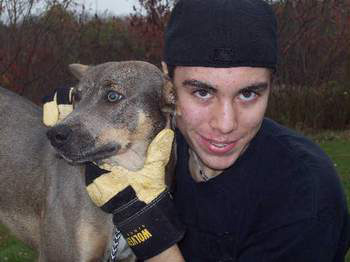The Canine Alimentary Canal 101
by Vicky Von Busse
It's not the breed Standard being discussed nor is it the
four legs,the wagging tail, or alert ears either. It's the
deep recesses of our wonderful pets that starts with the
sensational smile and lolling tongue they give us when
they are happy.
We've all admired those impressive teeth. But how
often have we equated that sparkling white smile to their
true function of grabbing, tearing and shredding? How
often have we considered that their molars are not flat to
address grinding up plant matter, but, in fact, are pointed
and overlapping like scissors to address meat, bones
and hide? How often have we acknowledged our dogs'
carnassial teeth? Hmmmmm. . . a pretty powerful and
impressive mouth, wouldn't you agree? :)
Those effective teeth work together with powerful jaw
and neck muscles; A must for any sensible canine who
often dreams of pulling down its prey. Ever wonder
why the mouth is such a huge gaping contraption? Ever
wonder why the lower jaw is incapable of a side-to-side
motion? It was designed so that when their captured prey
struggles, they can quickly be 'disposed' of. If our dogs
were equipped with the flat molars other animals possess
(i.e. humans, bears), their prey would meet a very
torturous end. :(
Now that the food is in their mouth, what happens?
Well, seeing that our noble canine has managed to tear
and chew on that piece of meat, thereby releasing the
meat's enzymes to begin 'self-digestion', he does what
any normal canine would do . . . . . he swallows. Ohhhh!
What a ride for that succulent piece of meat as it wends
its way down to that deep, dark, cavernous pit we call
the stomach....
And SPLASH!! Right into a warm hydrochloric acid
environment. Wonderful to feel that warmth as it begins
it's cleansing work on any pathogenic bacteria that came
along for the ride. But wait . . . . what's that happening?
Wow! A makeover! That potent hydrochloric acid is
beginning to break down that red blooded piece of meat.
And it works very efficiently and quickly.
And there is the pancreas smiling at this amazing dog
as it has made life so simple for the pancreas. Happily
the pancreas offers the enzymes needed to digest the
proteins and fats it encounters with no demand to produce
more for unnecessary carbohydrate luggage which would
encourage a whole myraid of health problems.
An uncomplicated life is what keeps this little organ
running effectively.
You're listening to:
"Chicken Chowder"
written by
Irene Giblin
As the partially transformed meat continues on its journey
it is surprised how quickly it moves along the digestive tract.
No one seems to have told it that the overall length of this
tract is actually very short and because of its short length it
is very adept in digesting a raw meal. Stool analysis of a
healthy raw meat fed dog shows that only a trace amount
of protein is lost and less than four percent of its fat intake
is unused. Ninety five percent of a raw meat meal is
effectively digested over a two to three hour period!
The end result: very compact, firm, small stool with relatively
little odor.
In contrast, a dig fed a commercially rendered animal
product does not get to prepare it's body for the meal.
The teeth are not exercised, the gums are not massaged,
the dead food gives off no preparatory enzymes prior to
entering the stomach, thereby placing an incredible burden
on the pancreas which then has to deal with not only
processed protein and fat, but also carbohydrates, cellulose
and starch found in commercially rendered animal products.
The more carbohydrates, cellulose and starch found in a
commercially rendered animal product, the more undigested
grain protein will sit in the upper small intestine. Sitting there
signals the body that there is a foreign substance that needs
to be addressed. This overstimulates the immune system
resulting in an host of health problems for our noble canine.
Depending on the content of the commercially rendered
animal product, digestion takes anywhere from 16 to 24 hours.
End result: voluminous, smelly stool
 | ||||||
 | ||||||
